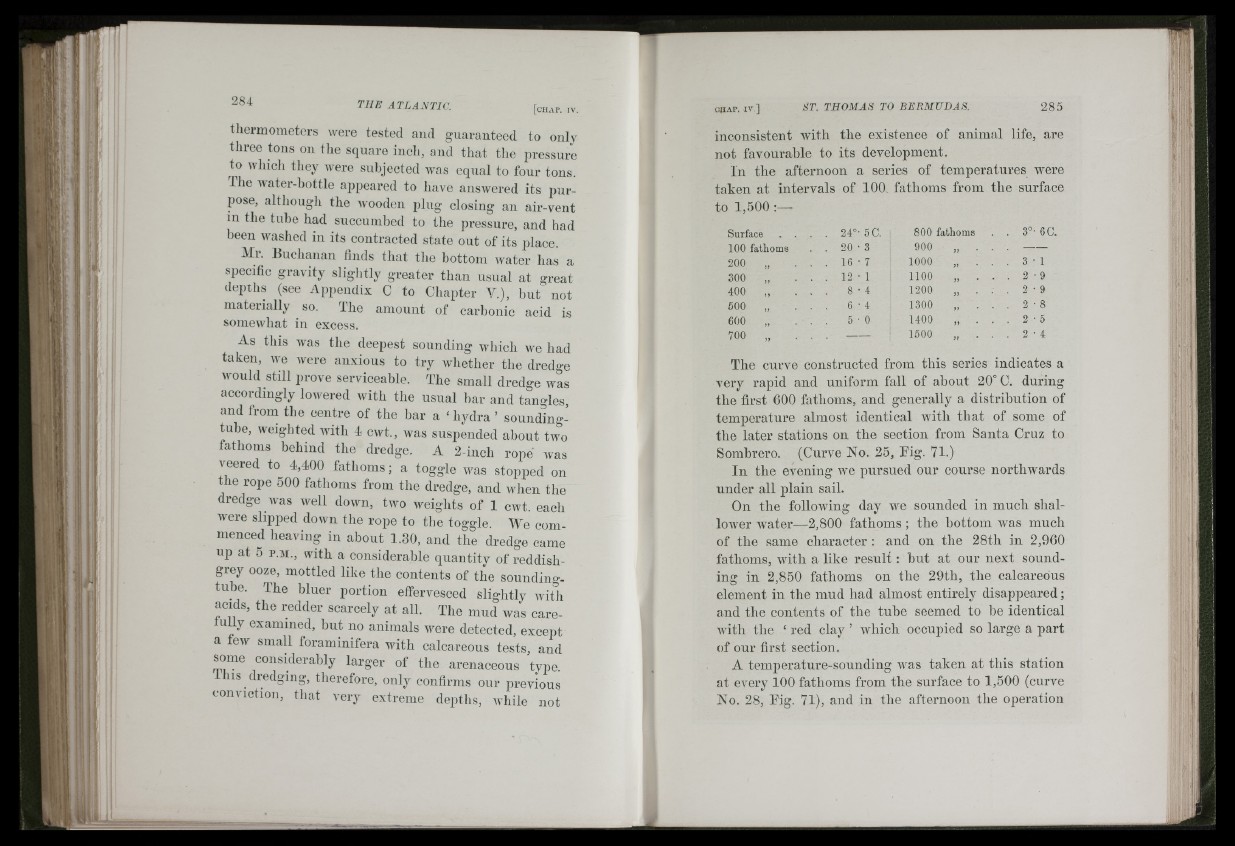
ft- ; 4
i l l ' !
liii
É 'i!
thermometers were tested and guaranteed t..o. o..xnixlyy
three tons on the square inch, and that the pressure
to whicii they Avere subjected was equal to four tons.
The Avater-bottle appeared to have ansAvered its purpose,
although the Avooden plug closing an air-vent
in the tube had succumbed to the pressure, and had
been Avashed in its contracted state out of its place.
Mr. Buchanan finds that the bottom Avater has a
specific gravity slightly greater than usual at great
depths (see Appendix C to Chapter Y.), but not
materially so. The amount of carbonic acid is
somewhat in excess.
As this Avas the deepest sounding Avhicli we had
taken, we were anxious to try whether the dredge
would still prove serviceable. The small dredge was
accordingly lowered with the usual bar and tangles,
and from the centre of the bar a ‘ hydra ’ sounding-
tube, weighted Avitli 4 cwt., Avas suspended about two
fathoms behind the dredge. A 2-inch rope Avas
veered to 4,400 fathoms; a toggle Avas stopped on
the rope 500 fathoms from the dredge, and when the
dredge was Avell doAvn, two weights of 1 cwt. each
were slipped down the rope to the toggle. We commenced
heaving iu about 1.30, and the dredge came
up at 0 P.M., with a considerable quantity of reddish-
grey ooze, mottled like the contents of the sounding-
tube. The bluer portion effervesced slightly with
acids, the redder scarcely at all. The mud was care-
tully examined, but no animals were detected, except
a fcAV small foraminifera Avith calcareous tests, and
some considerably larger of the arenaceous type.
us dredging, therefore, only confirms our previous
conviction, that very extreme depths, while not
inconsistent with the existence of animal life, are
not favourable to its development.
In the afternoon a series of temperatures were
taken at intervals of 100 fathoms from the surface
to 1,500
Surface . . 2 4 ° -5 C. 800 fathoms . . 3°- 60.
100 fathoms . . 2 0 - 3 900 „ . . . -------
200 „ . . 1 6 - 7 1000 „ . . . 3 - 1
300 „ . . 1 2 - 1 1100 „ . . . 2 • 9
400 „ 8 - 4 1200 „ . . . 2 • 9
500 „ 6 - 4 1300 „ . . . 2 - 8
600 „ 5 - 0 1400 „ . . . 2 - 5
700 „ . . ■ ------ 1500 „ . . . 2 • 4
The curve constructed from this series indicates :
very rapid and uniform fall of ahout 20° C. during
the first 600 fathoms, and generally a distribution of
temperature almost identical with tbat of some of
the later stations on the section from Santa Cruz to
Sombrero. (Curve No. 25, Fig. 71.)
In the evening Ave pursued our course northwards
under all plain sail.
On the following day we sounded in much shal-
loAver Avater—2,800 fathoms ; the hottom Avas much
of the same character : and on the 28th in 2,960
fathoms, with a like r esu lt; but at onr next sounding
in 2,850 fathoms on the 29th, the calcareous
element in the mud had almost entirely disappeared;
and the contents of the tube seemed to be identical
Avith the ‘ red clay ’ Avhich occupied so large a part
of our first section.
A temperature-sounding Avas taken at this station
at every 100 fathoms from the surface to 1,500 (curve
No. 28, Eig. 71), and in the afternoon the operation